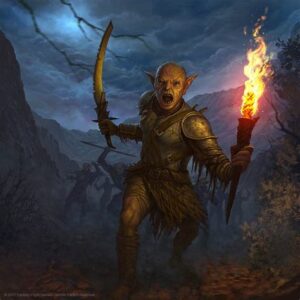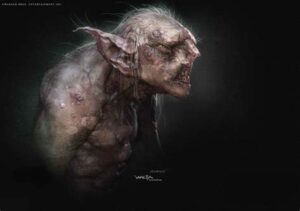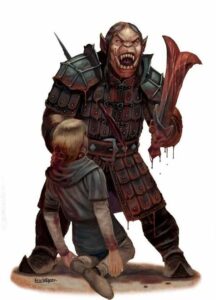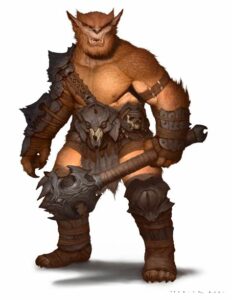The Goblin Races are collectively referred to as ‘humanoids’ by most people. (A term the smarter Goblins dislike intensely.) They are a very large population, according to some sages second in numbers after humans, while others feel that taken as a whole they may be the dominant population of Titan. Until about four hundred years ago MOST Goblins (Common and Haeb) were found on the continent of Lavalla and Parador. Having been all but exterminated on Solista by centuries of warfare with the Dwarves and Elves of that land. Only the Buge were found on all three of the continents, in their cold regions.
Actions taken by the the Caliph of Balaghad changed that. The Caliph fought numerous wars to expand his territories in Palador. During this expansion his armies had come up against many tribes of Goblins. Fierce battles had been waged against these creatures, battles which had pushed the tribes deeper into the wilderness and left the Caliph in possession of thousands upon thousands of prisoners. One of the Caliph’s advisors, a eunuch named Osmunna, hit upon the idea of using these prisoners as mercenaries to fight the Caliph’s enemies in distant lands.
First used in the campaigns to retake the island of Tabrizia, Balaghad troops, reinforced by a veritable horde of humanoids, easily took the island. With the island securely in Balaghad hands, most of the humanoids were loaded onto ships and sent elsewhere, to fight more battles until they were all used up or too old to cause trouble. Some however remained on Tabrizia. Several hundred all told had deserted and fled into the jungles and swamps where they would scratch out a living in contest with the original population. Their raids and depredations would prove a source of misery for all of Tabrizia for centuries to come.
Though Osmunna’s policy of employing Goblin mercenaries was popular at court, and brought him much prestige and wealth in his lifetime, it would eventually be discredited. What occurred on Tabrizia would be a pattern repeated everywhere the humanoids were used. As a result humanoid populations began cropping up in parts of the world where they had never before been known or had been absent from for millenia. These would become an ongoing source of anguish for later Caliph’s and eventually the Empire of Ilshar as well as many other nations.
The Goblin Races are subdivided into several distinct but related types.
The ‘Common’ Goblin (as they are called by humans, elves and dwarves) is the smallest and physically weakest, but also the most numerous of the species. They are, by most estimates, the smartest of the Goblin races and the ones most likely to build or mine, craft goods and manufacture and practice Arcane Magic. Some Sages claim that Goblin mining skills rival the Dwarves (though such is never said when a Dwarf is present.) Goblin smyths and crafters are at least the equal of their human counterparts in terms of ability, quantity and quality of their products. And although there is no record of any Goblin becoming a truly powerful Mage, low level ‘hedge’ type wizards are not uncommon, with some Goblin wizards even making magic items.
The Common Goblin, or simply Goblin, is often found in underground complexes or well constructed buildings, towns and even fortified cities. There are several Goblin City States in Palador, remnants of an ancient Goblin empire.
Being almost hairless, they are usually found in temperate to tropical climates (if above ground) or deep underground in cooler regions. In some parts of the world Goblin communities exist peacefully alongside humans, engaging in trade and even cooperative ventures. Such is NEVER true with Dwarves or Elves. The Goblin Wars with those species are the stuff of legend! And until the ‘reseeding’ by the Caliph of Balaghad, the reason there were virtually no Goblins found in the lands of Solista!

‘Common’ Goblin Warrior
A Common Goblin averages 3 to 4.5 feet in height and weigh in from 60 to 120lbs. It is hairless and has a skin color that varies over a range of colors from pale yellow to dark gray with oranges and reds and even shades of green. Spotted or piebald skin colors are not unknown. Goblins seem to pay no attention to skin color within their race. Though they have little hair, females have more on their heads then males, it is not uncommon for them to shave off what little they may have. Goblins have pronounced, pointed ears that range from large to huge! Like many animals, a Goblin’s ears give off nonverbal clues as to mood and emotions. Flattening when angry or fearful. Perking up when curious, etc. Some Goblins are actually able to control their ear movements. Though Goblin fingers have small, claw like nails they are none the less deft and nimble.

Goblin
‘Goblin’ the language, is universal amongst the Common Goblins regardless of where the individual goblin comes from, though there may be a regional accent or some odd local vocabulary. It is a true ‘Common Tongue’ and many human travelers, sailors and merchants use it.
The ‘Haeb’ or Hob-Goblin is larger, stronger and hairier then their smaller kin. They are also more violent, aggressive and fortunately rarer. They are by no means stupid and have their own culture and crafts, but are also known to trade extensively with their weaker kin for manufactured goods. Hob-Goblins are generally Agrarian/Hunter/Gatherers, often nomadic and usually construct dwellings of timber, fieldstone or, if nomadic, hides and poles. The Hob-Goblin is generally surface dwelling and is found in temperate forested and mountainous regions., generally avoiding tropical areas. Organized Goblin societies often employ their larger cousins as mercenaries and guards. The typical Hob-Goblin ranges in height from 5′ to 7′ and weigh between 180 to 300lbs. They have dark brown or black hair over a skin that is usually light gray or brown or greenish in color. The Hob-Goblins fingers are tipped with a hornier, thicker, claw like nail. They find small scale, delicate work frustrating and time consuming.

Haeb-Goblin
Goblins usually regard the Haeb as ‘country cousins’ or uneducated ‘hill-billies.’ For their part, the Haeb see the ‘Common’ Goblins as sly, treacherous and untrustworthy.
The ‘Buge’ or Buge-Goblin, commonly called a ‘Bug-Bear’ by humans, is the largest of the three common species. It is by far the biggest and strongest and hairiest. Its thick outer hair has given it the name ‘Bear’ because of its superficial resemblance to a bear’s fur.

Buge
Bug Bears are well suited to their preferred climate, the icy polar regions, high mountains, and frozen tundras. They do venture into warmer temperate regions, primarily to hunt, raid or ‘trade.’ Their dwellings are frequently underground, or built with ice and snow (think igloo.) Their crafting abilities are, lacking outside input, generally ‘stone age’ in level. But they are quite intelligent and are known to ally themselves with populations of Hob-Goblins and (rarely) Goblins. They also trade hides, ivory and other fruits of the hunt, for weapons and armor. Bug Bears range between 6; and 8′ in height and mass out between 300 and 500lbs. They rival Ogres in strength and the Bug Bear’s fingers and toes are tipped with a thick, weapon grade claw that makes even a disarmed Bug Bear a formidable opponent in close combat.
Both Goblins and Hob-Goblins regard their Buge cousins as, at best, barbaric savages. The Buge see both Haeb and Common Goblin as soft, weak and untrustworthy.
Despite the physical differences, all three of the goblin races can interbreed and variations are known. There is no innate loyalty or love between the three races and they have been known to slaughter each other as cheerfully as humans do with their own enemies. But all three will happily unite to kill Dwarves or Elves if given the opportunity.
The Goblin language is universal, though with regional accents, amongst the Common Goblins. The Goblin alphabet is closely related to the Dwarven runic alphabet.
Hob-Goblin is related to, though divergent from, ‘Classic’ Goblin. It is distinct enough to be considered by most Sages as a separate language, but Goblins and their Hob-Goblin cousins can muddle through a conversation, with some effort.
Talking with a Buge is another matter. In this case one party must know the other’s language, or they must share a common language.